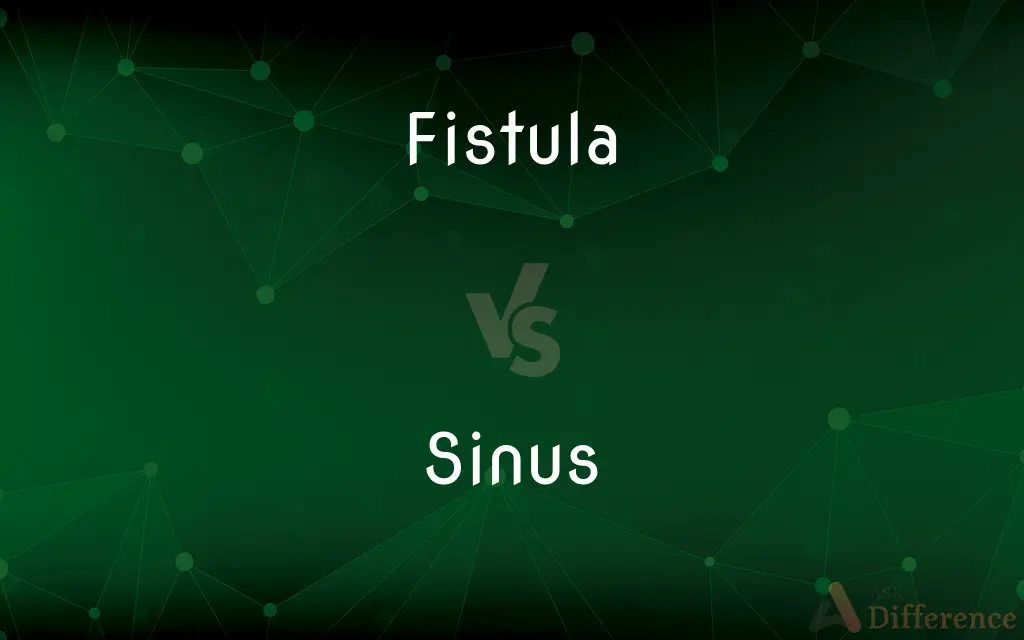Fistula vs. Sinus — What's the Difference?
By Urooj Arif & Fiza Rafique — Updated on March 29, 2024
A fistula is an abnormal connection between two body parts, such as organs or vessels, that normally do not connect, while a sinus is a cavity, channel, or passageway that is intended to drain fluid or pus, often leading to or from an area of infection.

Difference Between Fistula and Sinus
Table of Contents
ADVERTISEMENT
Key Differences
A fistula represents an abnormal pathway that forms between two internal structures or between an internal structure and the exterior of the body. This pathway can develop due to surgery, injury, infection, or inflammation, facilitating an unintended flow of air, bodily fluids, or waste between organs or out of the body. In contrast, a sinus is typically a naturally occurring or pathological cavity that serves the purpose of draining fluid or pus, often related to an infection. Sinuses can be normal anatomical features (such as the paranasal sinuses, which are air-filled spaces within the bones of the skull and face) or pathological channels that result from an infection or chronic inflammatory process, leading to a dead space that requires drainage.
Fistulas can occur in various parts of the body, including the gastrointestinal tract, between blood vessels, and between the intestines and other organs. They may cause significant clinical symptoms based on their location and the types of tissues involved, potentially leading to complications such as infection or nutrient malabsorption. On the other hand, a sinus may present as a tract or tunnel leading from a focus of infection to an external surface, which may discharge pus or other fluids. While sinuses are often associated with chronic infections, they can also result from acute processes where an outlet for pus or fluid accumulation is necessary.
The treatment for a fistula often involves surgery to remove the abnormal connection and repair the affected tissues, while the management of a sinus may require drainage, antibiotics, or sometimes surgical intervention to resolve the underlying infection and remove the sinus tract. The distinction between these two conditions is crucial for appropriate diagnosis and management.
While both fistulas and sinuses involve abnormal channels within the body, their causes, implications, and treatments differ. Fistulas represent a pathological connection between two spaces that should not normally communicate, with potential systemic effects depending on their location. Sinuses, however, are more closely associated with the body's response to infection or inflammation, acting as channels for drainage to the body's exterior or between different internal spaces.
Comparison Chart
Definition
An abnormal connection between two body parts.
A cavity or channel designed to drain fluid.
ADVERTISEMENT
Causes
Surgery, injury, infection, inflammation.
Infection, inflammation, sometimes anatomical.
Types
Between organs, vessels, or to the exterior.
Paranasal, pathological due to infections.
Symptoms
Unintended flow of fluids, possible infection.
Drainage of pus/fluid, associated with infection.
Treatment
Often surgical removal and tissue repair.
Drainage, antibiotics, sometimes surgery.
Compare with Definitions
Fistula
Can result from disease, injury, or surgery.
Crohn's disease can lead to the formation of intestinal fistulas.
Sinus
Associated with chronic infections when pathological.
A chronic infection caused the formation of a sinus tract in the skin.
Fistula
Treatment often involves surgery.
Surgical intervention was necessary to correct the anal fistula.
Sinus
Acts as an outlet for pus or fluid.
The sinus provided a necessary drainage route for the abscess.
Fistula
An abnormal pathway between two organs or surfaces.
The patient developed a fistula between the bladder and intestine following surgery.
Sinus
May be a normal anatomical feature or result from infection.
The paranasal sinuses are air-filled spaces within the skull.
Fistula
May cause complications like infection.
The intestinal fistula resulted in severe infections requiring aggressive treatment.
Sinus
Treatment can involve antibiotics or surgery.
Antibiotics were prescribed to treat the infection associated with the sinus.
Fistula
Can affect various body systems.
An arteriovenous fistula developed, compromising blood flow efficiency.
Sinus
A cavity or channel for fluid drainage.
The sinus tract led from the infected tooth to the gum surface.
Fistula
A duct or passage resulting from injury, disease, or a congenital disorder that connects an abscess, cavity, or hollow organ to the body surface or to another hollow organ.
Sinus
A depression or cavity formed by a bending or curving.
Fistula
Such a passage that has been created intentionally, especially a surgically constructed connection between an artery and a vein that is used for vascular access in hemodialysis.
Sinus
Any of various air-filled cavities in the bones of the skull, especially one communicating with the nostrils.
Fistula
(medicine) An abnormal connection or passageway between organs or vessels that normally do not connect.
Sinus
(Medicine) A fistula leading from a pus-filled cavity.
Fistula
(rare) A tube, a pipe, or a hole.
Sinus
(Botany) A recess or indentation between two lobes or segments, as of a leaf.
Fistula
The tube through which the wine of the Eucharist was once sucked from the chalice in certain ceremonies (such as papal Masses).
Sinus
A pouch or cavity in a bone or other tissue, especially one in the bones of the face or skull connecting with the nasal cavities the paranasal sinus.
Fistula
A reed; a pipe.
Sinus
(anatomy) An irregular venous or lymphatic cavity, reservoir, or dilated vessel.
Fistula
A pipe for convejing water.
Sinus
Relating to or denoting the sinoatrial node of the heart or its function of regulating the heartbeat.
Fistula
A chronic inflammation of the withers of a horse
Sinus
(pathology) An abnormal cavity or passage such as a fistula, leading from a deep-seated infection and discharging pus to the surface.
Fistula
An abnormal passage leading from a suppurating cavity to the body surface
Sinus
(botany) A rounded notch or depression between two lobes or teeth in the margin of a leaf or petal.
Sinus
(geography) A bay of the sea; a recess in the shore.
Sinus
(trigonometry) sine.
Sinus
An opening; a hollow; a bending.
Sinus
A bay of the sea; a recess in the shore.
Sinus
A cavity; a depression.
Sinus
A narrow, elongated cavity, in which pus is collected; an elongated abscess with only a small orifice.
Sinus
A depression between adjoining lobes.
Sinus
An abnormal passage leading from a suppurating cavity to the body surface
Sinus
Any of various air-filled cavities especially in the bones of the skull
Common Curiosities
How is a sinus related to infection?
Sinuses often form in response to infection, serving as a channel for draining pus or fluid.
What are common symptoms of a fistula?
Symptoms can include unintended leakage of bodily fluids, pain, and signs of infection.
What treatments are available for fistulas?
Treatment usually involves surgical intervention to close the fistula and may include antibiotics for associated infections.
Are sinuses always pathological?
Not always; some sinuses are normal anatomical structures, such as the paranasal sinuses, while others are pathological.
Can a fistula and a sinus occur together?
Yes, in some cases, a fistula may lead to the formation of a sinus tract as part of the body's response to infection or inflammation.
Can a sinus heal on its own?
Some sinuses may close on their own once the infection resolves, but others require medical or surgical treatment.
What is the main difference between a fistula and a sinus?
A fistula is an abnormal connection between two body parts, while a sinus is a cavity or passage that allows fluid drainage.
What complications can arise from untreated fistulas?
Untreated fistulas can lead to severe infections, nutrient malabsorption, and other systemic effects.
How are fistulas diagnosed?
Diagnosis may involve imaging studies, dye tests, and examination of the affected area.
Why might surgery be necessary for a sinus?
Surgery may be needed to remove the sinus tract and address the underlying cause of infection or to prevent recurrence.
Share Your Discovery

Previous Comparison
Visitation vs. Visit
Next Comparison
Sect vs. CultAuthor Spotlight
Written by
Urooj ArifUrooj is a skilled content writer at Ask Difference, known for her exceptional ability to simplify complex topics into engaging and informative content. With a passion for research and a flair for clear, concise writing, she consistently delivers articles that resonate with our diverse audience.
Co-written by
Fiza RafiqueFiza Rafique is a skilled content writer at AskDifference.com, where she meticulously refines and enhances written pieces. Drawing from her vast editorial expertise, Fiza ensures clarity, accuracy, and precision in every article. Passionate about language, she continually seeks to elevate the quality of content for readers worldwide.














































